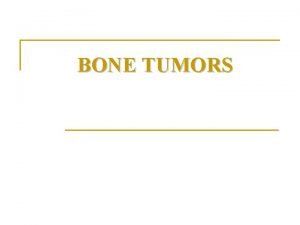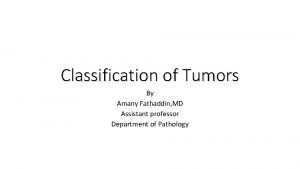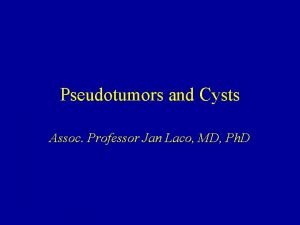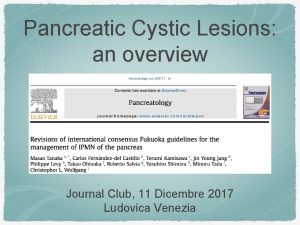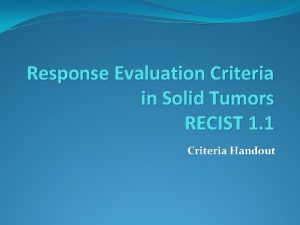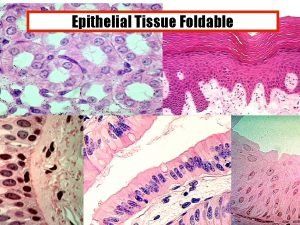Malignant Epithelial Tumors carcinoma Carcinomas are the commonest













- Slides: 13

Malignant Epithelial Tumors (carcinoma) Carcinomas are the commonest of all malignant tumors probably because epithelial cells are continuously replicating. Types of Carcinomas: Carcinomas of Surface Epithelium: 1. Squamous cell carcinoma. 2. Basal cell carcinoma 3. Transitional cell carcinoma Carcinoma of Glandular Epithelium: 1. Adenocarcinoma 2. Mucoid carcinoma 3. Undifferentiated carcinoma

• Squamous cell carcinoma • It is a malignant tumor of stratified squamous epithelium. • Sites: 1. Any site normally covered by stratified squamous epithelium e. g. skin, buccal cavity, esophagus, larynx, vagina, anal canal. 2. In areas of squamous metaplasia on top of: - Columnar epithelium e. g. in the upper respiratory tract, bronchi, and gall bladder. -Transitional epithelium e. g. in urinary passages (urinary bladder, ureter). Macroscopic appearance: • It starts as a small indurated mass (indurations are due to infiltration of the epithelial cells to the surrounding structure) which grows to become a hard nodule and takes one of the following shapes: A. Polypoid, fungating, cauliflower (papillary or exophytic carcinoma): • The mass may shows surface ulceration, necrosis and hemorrhages.

B. Nodular type (infiltrating carcinoma): • The malignant cells form a hard nodular mass beneath the surface and shows more rapid infiltration to the deeper structures but little surface ulceration and more rapid dissemination. C. Carcinomatous ulcer (ulcerative carcinoma): • The commonest type. • Both the above types usually ulcerate to from a typical ulcer. • It has a raised everted edge, fixed indurated base and necrotic floor which is usually white, friable and bleeds easily in touch.

B. Nodular type (infiltrating carcinoma): • The malignant cells form a hard nodular mass beneath the surface and shows more rapid infiltration to the deeper structures but little surface ulceration and more rapid dissemination. C. Carcinomatous ulcer (ulcerative carcinoma): • The commonest type. • Both the above types usually ulcerate to from a typical ulcer. • It has a raised everted edge, fixed indurated base and necrotic floor which is usually white, friable and bleeds easily in touch.

Microscopic picture (histological typing): a. Carcinoma in situ (intra epithelial carcinoma): • When the epithelium starts to show malignant changes, there is progressive irregular proliferation • Cellular pleomorphism, atypical mitotic activity and other features of dysplasia may become so marked that the epithelium give the impression of malignancy even though the cells have not broken through the basement membrane. • This is called carcinoma in situ or intraepithelial carcinoma. b. Invasive carcinoma: • It is the penetration of the basement membrane by masses of malignant cells, which then into the connective tissue and muscles. • The cells tend to break up into separate groups or columns.

v. Differentiation: A. Well differentiated tumors: • When differentiation is good, epithelial pearls (keratin pearls, epithelial pearls or cell nests) are formed. • Each mass or group of cells shows the same layers of normal stratified squamous epithelium with keratin inside and basal layer outside. • Epithelial pearl or cell nest consists of a central whorl of keratin which is red stained and laminated. • The outer cells in the mass consist of not well formed basal cell layer. • Inner to this layer is polyhydral cells with intercellular bridges and pale nuclei (prickle cell layer) form the main bulk of the mass. • Next to it a layer of granular cells (stratum granulosum) which are flattened with granular cytoplasm and darkly stained nuclei is occasionally present. • The cells of the nest or pearl are usually fairly uniform in size and shape, with evenly stained nuclei and scanty mitoses. • The skin is the commonest site and spread is slow.

B. Moderately differentiated tumors (less differentiated): • Cell nests are few in number and contain no obvious keratin, but groups of prickle cells may still be recognizable. • The cells show more marked anaplasia. C. Poorly differentiated (undifferentiated or anaplastic tumors): • There is no attempt at prickle cell formation. • There is diffuse sheets of neoplastic cells supported by a scanty, vascular stroma with no separation into groups. • The cells show great variation in size and shape. • Their nuclei are darkly stained and irregular in morphology, with abundant mitotic figures (some of these are bizarre). • This type of tumor is usually found in the mouth, nasopharynx, bronchus and cervix.

• Grading of squamous cell carcinoma (Broder’s classification): • Depends on the number of cell groups with cell nest appearance, four groups are recognized: • Grade I: More than 75% cell differentiated (keratinized groups) • Grade II: 50% to 75% cell differentiation. • Grade III: 25% to 50% cell differentiation. • Grade IV: less than 25% cell differentiation.

• Transitional cell (Urothelial) carcinoma • • • Malignant tumour of the urinary system Two types Papillary urothelial carcinoma (TCC) Solid urothelial carcinoma Glandular carcinoma 1. Adenocarcinoma: Sites: Common sites are stomach, colon, gall bladder and pancreas. Other sites are the endometrium, prostate, ovary and thyroid. Grossly: Malignant ulcer is the commonest type. Other types are solid, polypoid, annular or infiltrating growth. Several types may be identified according to their degree of differentiation:

Well differentiated forms: • Acinic carcinoma: The epithelium of the carcinoma exhibits a histologic tissue pattern resembling a glandular acinus as in colonic carcinoma. • Tubular carcinoma: The carcinoma mimics glandular tubules, e. g tubular carcinoma of the breast. Moderately differentiated forms: • Cribriform carcinoma: The epithelium of the carcinoma exhibits a “gland in a gland” pattern resembling a sieve, e. g. prostatic carcinoma • Papillary carcinoma: The epithelium of the carcinoma folds to form papilla, e. g papillary thyroid carcinoma.

• Grading of glandular carcinoma: Three features were taken into account when grading a tumour: 1 -Tubule formation. 2 - Regularity in size, shape and staining of nuclei pleomorphism. 3 - Number of mitosis • Spread: Direct infiltration, lymphatic spread with resulting regional lymph node metastasis and blood spread.

• 2 - Mucinous carcinomas • Several types of mucin-producing carcinomas are separated according to the quantity of mucin produced and where it is deposited. • Cystadenocarcinomas secrete massive amounts of mucin, creating a cavity in the tumor tissue, e. g ovarian mucinous cystadenocarcinoma. • Mucinous carcinomas produce massive amounts of mucin in the glandular acini of the tumor. This causes the acini to burst, creating extracellular deposits of a mucin, e. g. mucinous carcinoma of the colon. • Signet ring cell carcinomas are characterized by massive vacuolar accumulations of mucin with formation of “signet ring” cells, e. g. signet ring cell carcinoma of the stomach.

• Difference between Carcinoma and Sarcoma Aspect Carcinoma Sarcoma Nature Rate of growth Gross picture Malignant epithelial tumor Relatively slow Hard, non encapsulated mass. -fungating polypoid - M ulcer - infiltrating Malignant cells arranged in groups (glands or sheets) separated by dense stroma More common Radiosensitive Tissue of origin , SCC, Basal cell carcinoma, adenocarcinoma…. . Malignant mesenchymal tumor Very rapid Soft, large, fleshy non encapsulated mass - hemorrhage and necrosis Surrounding structure Early late Same Late Early Microscopic picture Incidence Radiotherapy Types and classification Spread Direct Lymphatic vascular Malignant cells are singly arranged separated by vascular stroma Less common Radioresistant Tissue of origin, Undiffrentated sarcoma, osteosarcoma, chondrosarcoma, leiomyosarcoma………




